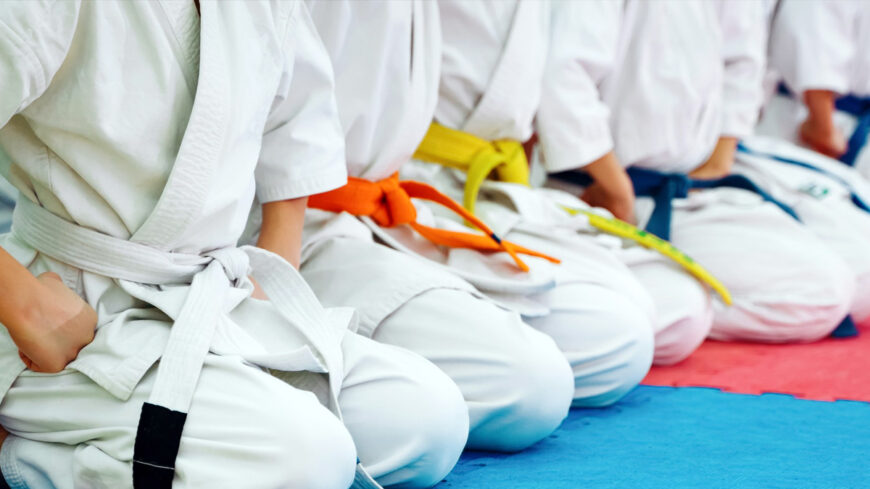You’ve probably watched a martial arts movie and seen karate students dressed in different colors. What do these colors denote, and are they all the same? The simple answer is they are not.
In Karate, belts denote your rank and experience. There are nine colored belts along the journey to becoming a karate master with a black belt.
Curious to find out more about karate belts? This article takes a deep dive into the karate belt orders, their colors, and what it takes to achieve each belt. Tighten your belt, and let’s get right into this.
The Karate Belt System
The student wears the karate belt around the waist during training sessions or competitions. It has no buckle or clasp but consists of two straps held together by a length of cord that passes through both ends. The cord ends are then tied together to secure them around your waist.
Most martial arts, such as karate, taekwondo, and kickboxing, implement the belt ranking system in their teachings. It is a system that ranks martial artists based on their skill level, experience, and competence.
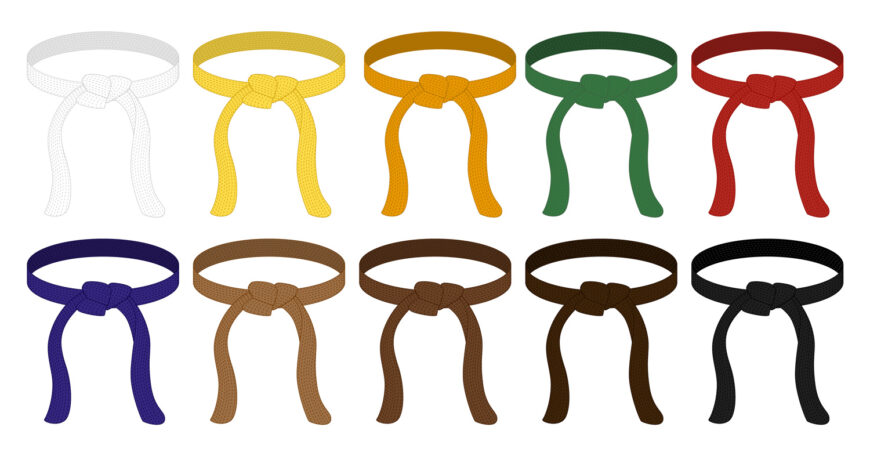
How Many Belts are In Karate?
The colors of the belt speak about the expertise and rank of anyone doing karate. White and black are the common colors we see in karate. White represents the beginner level, while the black belts represent a skilled professional.
There are nine belts in karate, going from white to black. The colors represent different levels of skills and expertise in practicing karate. White is a beginner’s belt, and black is an advanced student’s belt. However, it is imperative to note that there is more than one black belt in karate.
Here are the belts used in the karate ranking system:
First Belt: The White Belt
The white belt is the first belt in the karate belt order. This belt symbolizes the beginning of your journey in martial arts.
Martial artists begin as students, which means they do not know martial arts. Therefore, every teaching starts from scratch. They are usually children or teenagers who have had no exposure to martial arts before, so they tend to be very eager and willing students.
However, adults also wear the white belt when beginning their journey in karate. As they progress, they gain more experience and get belts of other colors.
Second Belt: The Yellow Belt
Once the student is through with the introductory classes, they get a yellow belt. The yellow belt is the second-lowest color belt in the Karate ranking system.
This yellow belt symbolizes light to show that the student is open-minded to facing possible challenges, methods, and techniques.
Third Belt: The Orange Belt
After earning your white and yellow belts, the orange belt is the third belt you’ll get. The orange belt symbolizes the spread of light, which means that the student’s knowledge is spreading and increasing.
The orange belt is an essential milestone in your karate journey because it symbolizes reaching a certain level of mastery. To earn an orange belt, you need to have mastered several karate moves or practiced for several months. However, it depends on your school’s karate system.
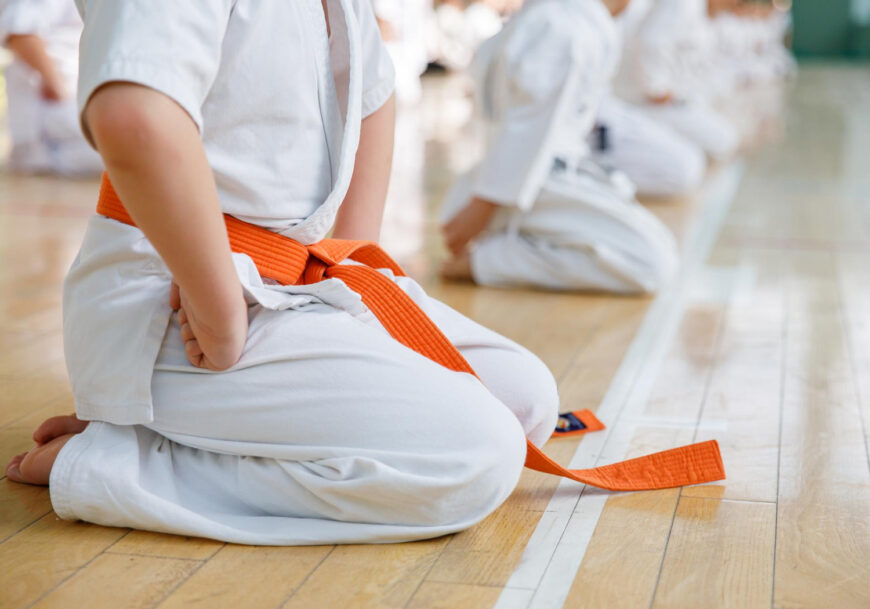
Fourth Belt: The Green Belt
The green belt is a symbol of continued growth and progress. Additionally, it symbolizes the student’s understanding of karate principles.
This belt is usually awarded to intermediate skills who have mastered several moves and are striving to refine the gained skills.
Fifth Belt: The Blue Belt
The blue belt is the fifth belt in karate which symbolizes the sky. At this level, a student understands various karate moves, having gone through the yellow, orange, and green ranks.
Blue belt holders are intermediate students who’ve started to gain advanced knowledge about karate and have learned the most basic techniques.
Their training will focus on refining those techniques with increased speed and power. At the same time, they will learn new moves as they advance to higher levels on their journey toward black belt status.
Sixth Belt: The Purple Belt
The purple belt symbolizes how the blue sky starts darkening at dawn. Therefore, it means that the karate practitioner at this level is gaining a more profound knowledge of karate.
Purple belt holders are students moving up to the ranks of advanced studies and mastering martial arts. This rank may take the karate student an average of 12 to 20 months to achieve. Once you conquer this rank, you are on your way to the top ranks of karate.
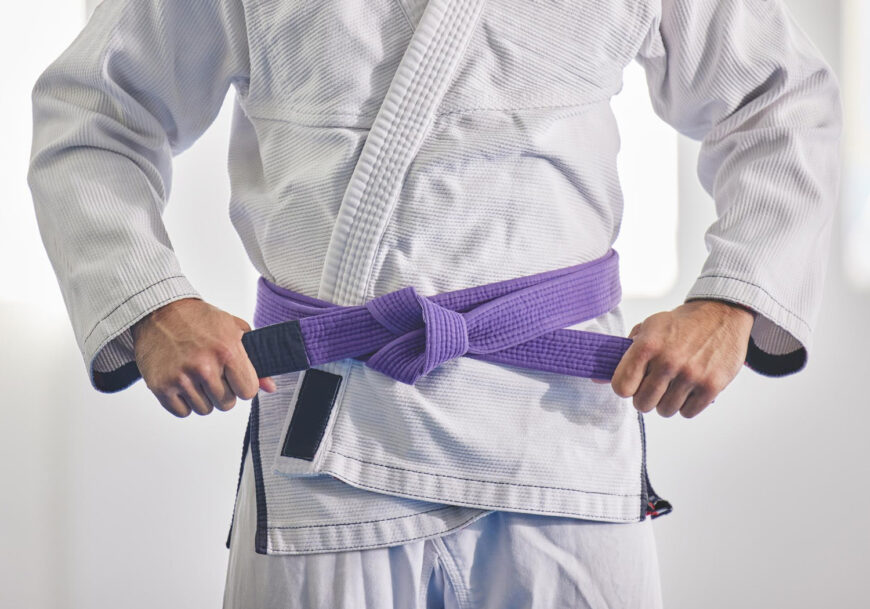
Seventh Belt: The Brown Belt
As the seed fully matures and starts ripening, it turns brown. The same scenario applies to this karate belt. It shows that the student has matured in martial arts practice and is ready to enjoy the ripe fruits of their hard work.
This seventh belt (depending on the karate system) is awarded to students who’ve shown maturity in skills and techniques.
Eighth Belt: The Red Belt
The red color in this belt represents the strength of the sun. Additionally, red is always associated with danger which means that red belt holders are dangerous since they have mastered most karate techniques.
Red belt holders may also take part in training the beginners due to their experience and understanding of the martial arts techniques. The brown and red belts are usually the last ranks before a karate student moves to the black belt rank, which signifies mastery.
Ninth Belt: The Black Belt
The highest and most coveted rank is the black belt which denotes that you’ve gone through the entire ranking system. A black belt holder is regarded as a master with enough experience to teach other students karate philosophy and techniques.
Though this is the ninth belt, it is not the last rank you can earn as a karate practitioner. Several other black belt ranks require dedication and patience for you to earn them.
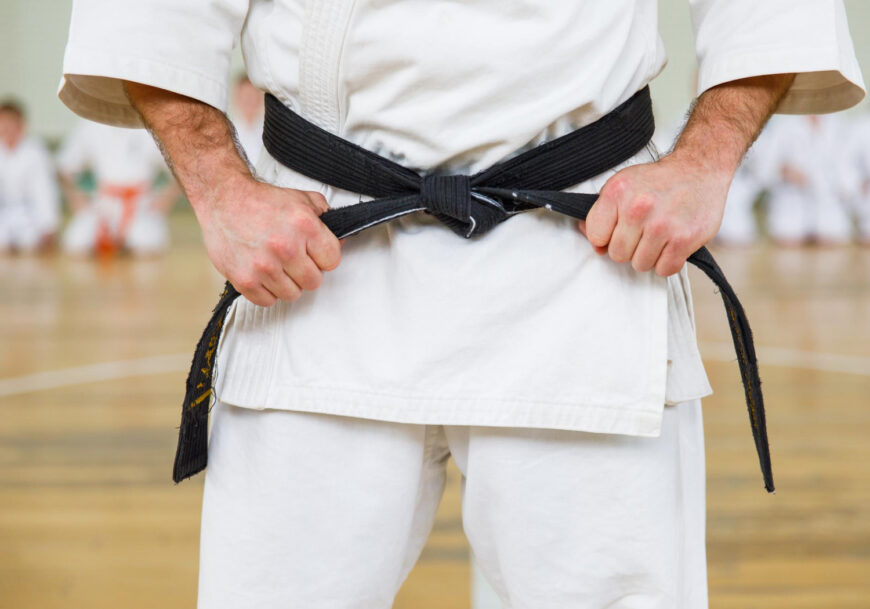
The Degrees of the Black Belt
Martial arts experts have long recognized the need for a standardized ranking system. In traditional Japanese martial arts, there are 10 degrees of black belt.
Here is the ranking system of the black belts:
- Sho-dan (first degree): Practitioners who have attained this level are considered beginners in the black belt ranks.
- Ni-dan (second degree): This belt is an award for those who have mastered the basic techniques and are ready to learn more advanced techniques.
- San-dan (third degree): The belt is for those karatekas who have demonstrated proficiency in various techniques.
- Yon-dan ( fourth-degree): This is an award for those who have shown mastery of the martial arts and can teach others.
- Go-dan (fifth degree): This belt is for those who have attained a high level of proficiency and are considered experts in martial arts.
- Roku-dan (sixth degree): A karate master who understands karate’s true essence.
- Nana-dan (seventh degree): An experienced karate master who has a deep understanding of the art of karate
- Hachi-dan (eighth degree): This is the belt reserved for masters who have practiced this art for a long time and are usually very experienced.
The Kyu-dan (ninth degree) and Ju-dan (10th degree) are the most prestigious ranks which are usually awarded to masters on an honorary basis. For instance, the USA Judo awarded Keiko Fukuda a 10th-degree black belt in 2011 when she was 98. This award made her the first woman to hold a 10th–degree black belt. [1]
Karate Belts Order In Different Karate Styles
The karate belt order is different in each karate style. Some of the karate styles in question include:
- Shotokan
- Kyokushin
- Shorin Ryu
- Wado Ryu
- Goju Ryu
- Uechi Ryu
- Chito Ryu
Shotokan Karate Belt Order
The Shotokan Karate belt orders can vary depending on the federation and individual school ranking system. Therefore, the ranking system used in Canada may be different from the one used in Japan.
As per the International Shotokan Karate Federation Belt (ISKF), these are the karate belts in Shotokan:
- 9th Kyu: The White Belt
- 8th Kyu: The Yellow Belt
- 7th Kyu: The Orange Belt
- 6th Kyu: The Green Belt
- 5th Kyu: The Purple Belt
- 4th Kyu: The Purple Belt
- 3rd Kyu: The Brown Belt
- 2nd Kyu: The Brown Belt
- 1st Kyu: The Brown Belt
Once you reach the 1st kyu, there are other ranks, i.e., 1st to 10th Dan Black belts. Though some kyus have belts with the same colors, the qualifications for achieving the belts are different.[2]
Kyokushin Karate Belt Order
In Kyokushin Karate, the order is as follows:
- Mukyu: White belt
- 10th Kyu: Orange belt
- 9th Kyu: Orange belt with blue stripe
- 8th Kyu: Blue belt
- 7th Kyu: Blue belt with green stripe
- 6th Kyu: Yellow belt
- 5th Kyu: Yellow belt with orange stripe
- 4th Kyu: Green belt
- 3rd Kyu: Green belt with brown stripe
- 2nd Kyu: Brown belt
- 1st Kyu: Brown belt with black stripe
How to Stay in Martial Arts Training
Your journey into martial arts training does not end when you leave the dojo. The most valuable part of all martial arts is the knowledge you’ve gained. All you can do is practice, practice, and more practice.
Whether you want to stick with it for a year or two or just months, staying committed to your training and martial arts classes is important.
History of Karate Belt
Many myths surround the history of using belts to denote ranks in martial arts. Some people believed there were only two belts; the black and white belt. Martial artists would wear a white belt while beginning their training. Then, it would turn colors eventually.
According to this story, martial artists didn’t wash their belts. Therefore, as they practiced and went to wars/competitions, the belt would turn yellow, green, then brown due to dirt. Eventually, the belt would turn black.
We can trace the real history of karate belts back to the Judo founder, Jigoro Kano. He borrowed the belt system from Japan, where he had seen people using a ranking system during competition. For example, the Japanese game, Go [3] used a ranking system to ensure that only players of the same level competed in a game, which promotes equality.
Jigoro Kano adopted the kyu/dan system in Judo, which laid the foundation for using different belt colors to denote ranks. Later, in the 1920s, Gichin Funakoshi adopted the kyu/dan ranking system in Shotokan karate. [4]
The use of belts to denote ranks spread widely. The Chinese and Korean martial arts also started using a ranking system in their training. However, each style/ martial arts school uses a different color order to denote ranks from beginner to master.
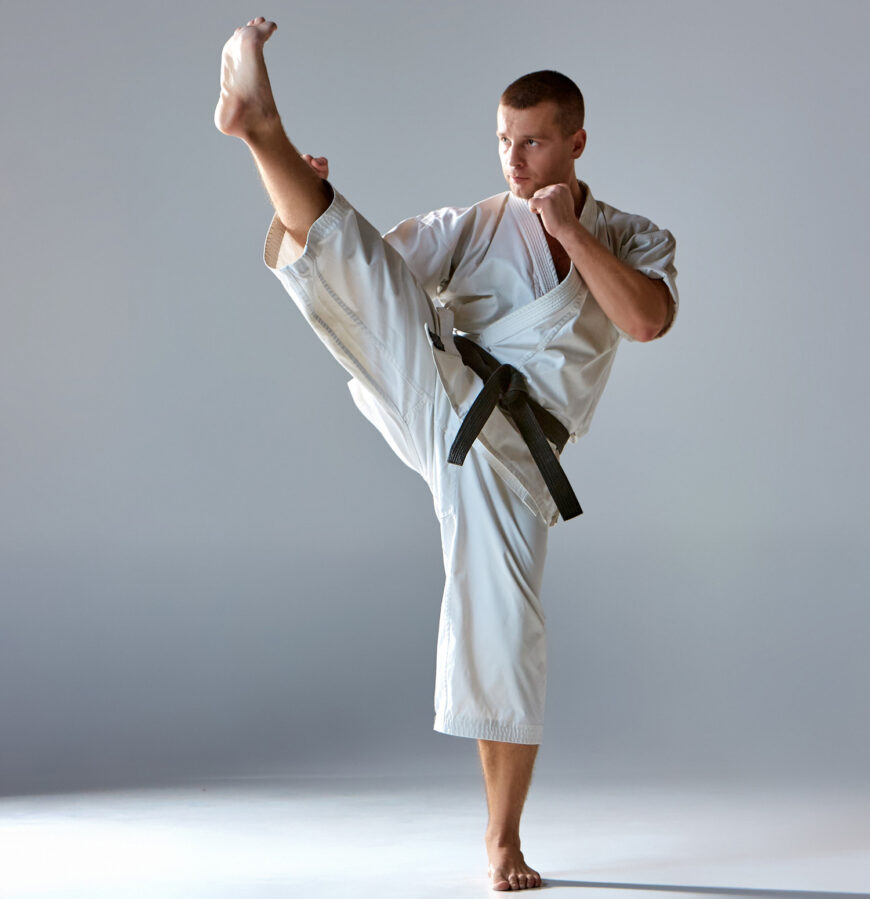
How To Achieve a Higher Rank in Karate?
The best way to achieve a higher rank in karate is to train hard, practice more and learn from your mistakes. If you have trouble with a particular technique, it may be time to ask an instructor for help.
Work on improving your physical, mental, and spiritual skills to achieve a higher rank in karate. These three areas are important aspects of karate that can make you a better martial artist and help you reach your goals.
Physical
The physical aspect of karate is all about becoming physically fit and strong. This aspect includes developing good muscle tone and increasing your stamina for long training sessions.
It also includes learning how to use your body properly to perform techniques correctly without getting hurt or injuring someone else during sparring or competitions.
Mental
The mental aspect of karate focuses on developing the mind to control your emotions better during competition or self-defense situations. This includes learning to focus on what needs to be done instead of letting emotions get the best of you during stressful situations such as fights or arguments with others.
It also means being able to think quickly on your feet so that you can react quickly if an opponent tries something unexpected during sparring matches or competitions against other schools.
FAQS
How many belts in karate?
There are 9 belts in karate, going from white to black.
Can you lose your black karate belt?
No, the black belt signifies your karate success and is an important part of your martial art education.
What is the karate belt order?
The karate belt order is a white belt, yellow belt, orange belt, green belt, blue belt, purple belt, brown belt, red belt, and black belt.
Which is the highest belt in karate?
The highest-ranking belt in karate is the black belt. However, there are different degrees of black belts. These degrees depend on your expertise.
Working Your Way Up
Remember that the number of belts you have does not matter as much as the skills you’ve learned and mastered. If you keep working hard and putting in the time and effort, you will eventually reach your goal. Soon after achieving your first black belt, another first-degree black belt may appear even closer than before.
The trick is to be consistent and keep working your way up. Are you curious to discover how long it will take you to achieve the black belt? Check out this guide on martial arts black belts as you work your way to the top!

